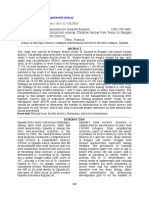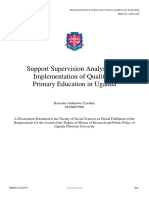Zambian Open University Thesis Cover
Zambian Open University Thesis Cover
Uploaded by
Anthony MulengaCopyright:
Available Formats
Zambian Open University Thesis Cover
Zambian Open University Thesis Cover
Uploaded by
Anthony MulengaOriginal Description:
Copyright
Available Formats
Share this document
Did you find this document useful?
Is this content inappropriate?
Copyright:
Available Formats
Zambian Open University Thesis Cover
Zambian Open University Thesis Cover
Uploaded by
Anthony MulengaCopyright:
Available Formats
ZAMBIAN OPEN UNIVERSITY
NAMPOLELE KASWAYA SIN. 2091690
A STUDY TO ESTABLISH THE PREVALENCE RATE OF STUNTING IN CHILDREN UNDER-FIVE (5) YEARS AT KAPIRI MPOSHI URBAN DISTRICT CLINIC
A Final Thesis Proposal To The Academic Department Of the School of Social Sciences In Partial Fulfilment of Requirements For a Bachelor Degree in Development Studies
DEDICATION
TABLE OF CONTENT Abstruct..................................................................................................................................... i Research Topic...........................................................................................................................1 Purpose ......................................................................................................................................2 Literature review........................................................................................................................3 Statement of the problem...................7 Objectives...................................................................................................................................8 Rationale.....................................................................................................................................9 Methodology......................................................9 Annex1 15 Annex 2.. 16 Annex 3 Bibliography 18 20
ABSTRACT Zambia is one of the 22 countries with the highest burden of under nutrition among the under-five year olds. Many suffer from different forms of malnutrition such as low birth weight, wasting, underweight, multiple micronutrient deficiencies such as iron, iodine deficiency However under nutrition in infancy and early childhood is thought to adversely affect cognitive development, although evidence of lasting effects is not well established. Lancet (2008) shows that approximately 30% of the world population is suffering from stunting. According to the Zambia Demographic Health Survey (2007) stunting in children less than five years of age is above 45% with 21% severe stunted. This is due to poor maternal nutrition leading to low birth weight babies. Low birth weight predisposes children to high risk of infection and malnutrition and permanent disadvantage. Stunted children at 24 months often suffer permanent losses to health, growth, learning capacity, and productivity throughout their life time. Routinely Zambia has been able to assess childrens growth using one growth indicator, weight for age (under weights), leaving out length for age (stunting) and length for weight (wasting). There is need to assess a child comprehensively so that all the three indicators are assessed. This way no child will be missed in terms of assessing the nutrition status. This paper will show how the stunting levels of under five children reporting to Kapiri Urban and Masansa Rural community will be established. The main objective will be to establish the prevalence rate of stunting in children among the under two years reporting at Kapiri Urban Clinic and Masansa Rural Health Centre. Some of the specific objectives will be to assess the growth of all under five year olds reporting to Kapiri Mposhi Urban Clinic and Masansa Rural health Centre. The other specific objective will be to sensitize community members. Data will be captured from 10% of the population for each site and will be analysed using graphs. Routinely mothers whose babies found to be stunted will be counselled accordingly. Finally the report will be compiled.
I BIBLIOGRAPHY Adair, L. S et al (1999). Filipino children exhibit catch-up growth between ages 2 and 11. J. Nutrition. 129:1140-1148. Adair, L. S et al (1993). Growth dynamics during the first two years of life: A prospective study in the Philippines. Eur. J. Nutrition 47:42-51 Alderman, H., J. Hoddinott, and B. Kinsey. (2003). Long Term Consequences of Early Childhood Malnutrition. Washington, DC:World Bank. Grantham-McGregor, S. (1995). A review of studies of the effect of severe malnutrition on mental development. J. Nutrition. 125:22335-22385. Guthrie, G.M., et al (1977). The Philipine Non-Verbal Intelligence Test. J. Soc. Psychology. 102:3-1 Laura E at el (). Stunting, Wasting, and Micronutrient Deficiency Disorders. Olivieri, F., Semproli, S.,Pettener, D., & Toselli, S. (2007). Growth and malnutrition of rural zimbabwean children (6-17 years of age). American Journal of Physical Anthropology. The Cebu Study Team (1991). Underlying and proximate determinants of child health: The Cebu Longitudinal Health and Nutrition Study. Am. J. Epidemiol 133: 185-201. The Zambia Demographic health Survey (2007). Lusaka: Ministry of health Zambia Central Statistics Office - Population Survey Report 2010.
You might also like
- Fundamentals of SurveyingDocument611 pagesFundamentals of Surveyingrvkumar361969092% (62)
- Fundamentals of SurveyingDocument611 pagesFundamentals of Surveyingrvkumar361969092% (62)
- 15commitments Book Firstchapter1Document28 pages15commitments Book Firstchapter1ShreyRawat80% (10)
- Fit To Work JenniferDocument1 pageFit To Work JenniferGerry Boy BailonNo ratings yet
- Annotated BibliographyDocument3 pagesAnnotated Bibliographyapi-4513030370% (1)
- Madrasa Education SystemDocument13 pagesMadrasa Education Systemasifiqbal87100% (1)
- Introduction To CartographyDocument47 pagesIntroduction To CartographyAnthony Mulenga100% (1)
- Kirk Medical LetterDocument1 pageKirk Medical LetterSteve WarmbirNo ratings yet
- Treating The Divergent MeridiansDocument6 pagesTreating The Divergent MeridiansMichalina Marta Marciniak100% (2)
- Malnutrition Research ProjectDocument34 pagesMalnutrition Research ProjectScribdTranslationsNo ratings yet
- Factors Associated With Early Pregnancies Among Adolescent Girls Attending Selected Health Facilities in Bushenyi District, UgandaDocument12 pagesFactors Associated With Early Pregnancies Among Adolescent Girls Attending Selected Health Facilities in Bushenyi District, UgandaKIU PUBLICATION AND EXTENSIONNo ratings yet
- MalnutritionDocument27 pagesMalnutritionOviya DharshiniNo ratings yet
- Factors Influencing Rural Teenage Girls' Menstrual Hygiene ManagementDocument31 pagesFactors Influencing Rural Teenage Girls' Menstrual Hygiene ManagementInternational Journal of Innovative Science and Research TechnologyNo ratings yet
- Health Seeking Behaviors and Management Methods For Menstrual Pain Among Female Senior High School Teenagers in AgogoDocument59 pagesHealth Seeking Behaviors and Management Methods For Menstrual Pain Among Female Senior High School Teenagers in AgogoInternational Journal of Innovative Science and Research TechnologyNo ratings yet
- Rethinking Sexual and Reproductive Rights and Health of Women in NigeriaDocument75 pagesRethinking Sexual and Reproductive Rights and Health of Women in Nigeriashzwe100% (1)
- Challenges Faced by Visually Impaired Students at Makerere and Kyambogo UniversitiesDocument12 pagesChallenges Faced by Visually Impaired Students at Makerere and Kyambogo UniversitiesDesire ramsNo ratings yet
- Ester-Final Report Dissertation 2017Document78 pagesEster-Final Report Dissertation 2017jimmy gheton100% (1)
- My Complete ProjectDocument55 pagesMy Complete Projectmitika usmanNo ratings yet
- Research Project ReportDocument42 pagesResearch Project ReportmutsapoNo ratings yet
- Nyakundi, Teresa KemuntoDocument92 pagesNyakundi, Teresa KemuntoRona AnyogNo ratings yet
- STUDENTS' CHEATING DURING EXAMINATIONS IN SOME SELECTED SECONDARY SCHOOLS OF LIBAN ZONE, SOMALI REGIONAL STATE (HARAMAYA UNIVERSITY Sep, 2014)Document98 pagesSTUDENTS' CHEATING DURING EXAMINATIONS IN SOME SELECTED SECONDARY SCHOOLS OF LIBAN ZONE, SOMALI REGIONAL STATE (HARAMAYA UNIVERSITY Sep, 2014)Henok Tesfaye100% (1)
- Factors Influencing Malnutrition Among Children Under 5 Years of Age in Kweneng West District of BotswanaDocument76 pagesFactors Influencing Malnutrition Among Children Under 5 Years of Age in Kweneng West District of BotswanaPaulin koffi100% (1)
- Carlo G. AlmazarDocument241 pagesCarlo G. AlmazarJeffreydanceljr100% (1)
- General Instructions For Students Attempting Open Book Examination PaperDocument2 pagesGeneral Instructions For Students Attempting Open Book Examination PaperSardar Ahsan suduzaiNo ratings yet
- Background of The StudyDocument4 pagesBackground of The StudyKevssNo ratings yet
- RH ProjectDocument20 pagesRH ProjectMerwan KemalNo ratings yet
- AGRIC SYLLABUS Compressed PDFDocument55 pagesAGRIC SYLLABUS Compressed PDFMartha ChloeNo ratings yet
- 03 A038 42390Document10 pages03 A038 42390priyanka sharmaNo ratings yet
- Proposal Research, KimDocument32 pagesProposal Research, Kimfiraol mokonnen100% (1)
- Low Academic AchievementDocument3 pagesLow Academic AchievementCes SevillaNo ratings yet
- Social Media Influence in AdolescenceDocument20 pagesSocial Media Influence in Adolescencealphonsa kuriakoseNo ratings yet
- Review of Litrature FinalizedDocument15 pagesReview of Litrature FinalizedSirajudinNo ratings yet
- Helen Berihun PDFDocument65 pagesHelen Berihun PDFdursaNo ratings yet
- Kpaake Thaddeus Terkimbi ProjectDocument59 pagesKpaake Thaddeus Terkimbi ProjectsimonNo ratings yet
- UNESCO - World - Declaration - On - Education - For - All 1990Document22 pagesUNESCO - World - Declaration - On - Education - For - All 1990Francis A. BuenaventuraNo ratings yet
- Education and Culture of AfghanistanDocument5 pagesEducation and Culture of AfghanistanMichael Roy CabalquintoNo ratings yet
- Mr. Milimo FinalDocument37 pagesMr. Milimo FinalEvangelist Kabaso SydneyNo ratings yet
- Exam Malpractice AssignmentDocument7 pagesExam Malpractice AssignmentSani Barde100% (1)
- Abiy YohannesDocument98 pagesAbiy YohannesIRENE LYKA VENTURANo ratings yet
- Factors Related To Malnutrition Among Children Below Five Years in Rengen Health Center III, Kotido DistrictDocument13 pagesFactors Related To Malnutrition Among Children Below Five Years in Rengen Health Center III, Kotido DistrictKIU PUBLICATION AND EXTENSION100% (1)
- Perception of Lecturers and StudentsExamination MalpracticeDocument42 pagesPerception of Lecturers and StudentsExamination Malpracticemusa sanneh100% (2)
- Commercialization of Education EssayDocument3 pagesCommercialization of Education EssayKholah RizwanNo ratings yet
- Food Quality SurveyDocument5 pagesFood Quality SurveyPrashant TripathiNo ratings yet
- Nancy,,, GITARI PROJECTDocument46 pagesNancy,,, GITARI PROJECTjohn mwambu0% (1)
- Factors Contributing To and Biological Concepts About Early Pregnancy Among Filipino Adolescent MothersDocument10 pagesFactors Contributing To and Biological Concepts About Early Pregnancy Among Filipino Adolescent MothersIJPHSNo ratings yet
- Final Exam: Bio-Psychological Foundation of EducationDocument8 pagesFinal Exam: Bio-Psychological Foundation of EducationRoselle LagamayoNo ratings yet
- Benefits of Sexuality Education For Young People in NigeriaDocument12 pagesBenefits of Sexuality Education For Young People in NigeriaDebby Wura AbiodunNo ratings yet
- Sexual and Reproductive Health of Young People With Disability in Ethiopia A Study On Knowledge, Attitude and Practice A Cross-Sectional StudyDocument11 pagesSexual and Reproductive Health of Young People With Disability in Ethiopia A Study On Knowledge, Attitude and Practice A Cross-Sectional StudyKharohmah SNo ratings yet
- Effect of Breakfast Skipping On Young Females MenstruationDocument16 pagesEffect of Breakfast Skipping On Young Females MenstruationRininta EnggartiastiNo ratings yet
- Relationship Between Teachers' Qualities and Pupils' Academic Performance in Pankshin Education Zone, Plateau State, NigeriaDocument94 pagesRelationship Between Teachers' Qualities and Pupils' Academic Performance in Pankshin Education Zone, Plateau State, NigeriavdomshakNo ratings yet
- Incidence of Malaria Among Children Under Five YearsDocument43 pagesIncidence of Malaria Among Children Under Five YearsUsman Ahmad TijjaniNo ratings yet
- The Analysis of Factors Affecting Choice of CollegeDocument12 pagesThe Analysis of Factors Affecting Choice of Collegesekar_smrNo ratings yet
- Corporate Social Responsibility As A Conflict Management Strategy in Selected Oil Producing Communities inDocument157 pagesCorporate Social Responsibility As A Conflict Management Strategy in Selected Oil Producing Communities inchukwu solomonNo ratings yet
- Dr. Sandhya Sharma - Divya - SharmaDocument15 pagesDr. Sandhya Sharma - Divya - SharmaSanskar VermaNo ratings yet
- The Effects of Online Games On Typing Skills of STDocument19 pagesThe Effects of Online Games On Typing Skills of STJhon Pol CailaoNo ratings yet
- Malambo ThesisDocument87 pagesMalambo Thesisvanessa langaNo ratings yet
- National Knowledge CommisonnDocument36 pagesNational Knowledge CommisonnKaran TalwarNo ratings yet
- Press Release (Wassce 2023)Document3 pagesPress Release (Wassce 2023)Fred Dzakpata100% (1)
- EOC DICAC Child Protection PolicyDocument14 pagesEOC DICAC Child Protection PolicyYonNo ratings yet
- Esubalew AmsaluDocument74 pagesEsubalew AmsaluD100% (2)
- Access and Equity To Higher Education in UgandaDocument20 pagesAccess and Equity To Higher Education in UgandaRana VampNo ratings yet
- Support Supervision Analysis and Implementation of Quality of Primary Education in UgandaDocument74 pagesSupport Supervision Analysis and Implementation of Quality of Primary Education in UgandaInternational Journal of Innovative Science and Research TechnologyNo ratings yet
- Correspondence Education - Shrooti ShahDocument29 pagesCorrespondence Education - Shrooti ShahRachana Karki100% (1)
- Ignou Research Proposal 176381740Document3 pagesIgnou Research Proposal 176381740Prakash KatakamNo ratings yet
- Strategies To Promote and Support Exclusive Breastfeeding in South AfricaDocument29 pagesStrategies To Promote and Support Exclusive Breastfeeding in South Africaapi-267284630No ratings yet
- Early Childhood Education and Development in Indonesia: An Assessment of Policies Using SABERFrom EverandEarly Childhood Education and Development in Indonesia: An Assessment of Policies Using SABERNo ratings yet
- Third and Fourth Year Curriculum For Civil EngineeeringDocument38 pagesThird and Fourth Year Curriculum For Civil EngineeeringAnthony MulengaNo ratings yet
- Cie 442 Assign 1Document17 pagesCie 442 Assign 1Anthony MulengaNo ratings yet
- Environmental Impact Assessment Process Final Environmental Impact Assessment Report Proposed ... PDFDocument236 pagesEnvironmental Impact Assessment Process Final Environmental Impact Assessment Report Proposed ... PDFAnthony MulengaNo ratings yet
- LVL Handbook PDFDocument226 pagesLVL Handbook PDFAnthony MulengaNo ratings yet
- 2 PrecipitationDocument61 pages2 PrecipitationAnthony MulengaNo ratings yet
- Solid Waste Management: CIE 442 Environmental Engineering Lecture Two Lecturer: Eng. Goodson MashekaDocument45 pagesSolid Waste Management: CIE 442 Environmental Engineering Lecture Two Lecturer: Eng. Goodson MashekaAnthony Mulenga100% (1)
- Water Pollution Lecture Notes Five CIE 442 (Edited)Document67 pagesWater Pollution Lecture Notes Five CIE 442 (Edited)Anthony MulengaNo ratings yet
- Civil Engineering Drawings CIE 222Document32 pagesCivil Engineering Drawings CIE 222Anthony MulengaNo ratings yet
- Lecture Four Cie 442 Disposal 2020Document24 pagesLecture Four Cie 442 Disposal 2020Anthony MulengaNo ratings yet
- Lecturer: Muumbe K. Lweendo: School of Science, Engineering & TechnologyDocument46 pagesLecturer: Muumbe K. Lweendo: School of Science, Engineering & TechnologyAnthony MulengaNo ratings yet
- GroundwaterDocument94 pagesGroundwaterAnthony MulengaNo ratings yet
- 6a.hydrographs Construction and AnalysisDocument49 pages6a.hydrographs Construction and AnalysisAnthony MulengaNo ratings yet
- Abi Ntro Ec0 1 2 3 5 M Cullen 0 PDFDocument105 pagesAbi Ntro Ec0 1 2 3 5 M Cullen 0 PDFAnthony MulengaNo ratings yet
- CIE 311 Notes1 - Regulatory Framework, StandardsDocument4 pagesCIE 311 Notes1 - Regulatory Framework, StandardsAnthony MulengaNo ratings yet
- Variation Claim VGLuxDocument2 pagesVariation Claim VGLuxAnthony MulengaNo ratings yet
- Project Monitoring and EvaluationDocument116 pagesProject Monitoring and EvaluationAnthony MulengaNo ratings yet
- Weight-For-Age BOYS: Birth To 5 Years (Z-Scores)Document1 pageWeight-For-Age BOYS: Birth To 5 Years (Z-Scores)Anthony MulengaNo ratings yet
- Classic Planning Set SampleDocument4 pagesClassic Planning Set SampleAnthony MulengaNo ratings yet
- Hydrology Principles Analysis DesignDocument477 pagesHydrology Principles Analysis DesignCarel De Jager82% (17)
- Draft Essay With ConceptsDocument11 pagesDraft Essay With ConceptsAnthony MulengaNo ratings yet
- Module For OshDocument2 pagesModule For OshHassahDah SeRolfalliv LaDivNo ratings yet
- Exposure Calculator Noise Level (L DB) Exposure Duration (Hours)Document2 pagesExposure Calculator Noise Level (L DB) Exposure Duration (Hours)Gustavo AlcântaraNo ratings yet
- Decode Civils Philosophical Essay Writing SampleDocument13 pagesDecode Civils Philosophical Essay Writing SampleNik SirNo ratings yet
- HDF Health Declaration Form (May-2016) - 2Document1 pageHDF Health Declaration Form (May-2016) - 2Tabish IslamNo ratings yet
- Ethical Issues With Gene TherapyDocument3 pagesEthical Issues With Gene TherapyMargarita ArnoldNo ratings yet
- ZEMA ProfileDocument6 pagesZEMA ProfilekellymajewsNo ratings yet
- Tumor Payudara: I Made Andre PradnyanaDocument38 pagesTumor Payudara: I Made Andre PradnyanaAndre PradnyanaNo ratings yet
- SDS Alum Sulfate (Liq)Document6 pagesSDS Alum Sulfate (Liq)Opet BikesNo ratings yet
- A Perfect Storm Examining The Supply Chain For N95 Masks During Covid-19Document12 pagesA Perfect Storm Examining The Supply Chain For N95 Masks During Covid-19Mark RojasNo ratings yet
- Types of Fitness ActivitiesDocument7 pagesTypes of Fitness ActivitiesMark Joshua MandaniNo ratings yet
- DR Beckett Case Solutions - Group 8Document9 pagesDR Beckett Case Solutions - Group 8Anik ChakrabortyNo ratings yet
- Venues of Health Habit ModificationDocument3 pagesVenues of Health Habit ModificationSisily GeorgeNo ratings yet
- SUPPLY SIDE West 2021Document48 pagesSUPPLY SIDE West 2021Hebei Meishen Sira100% (1)
- MLM Module 3 - Immunization SafetyDocument41 pagesMLM Module 3 - Immunization Safetyhrhpalimbang2024No ratings yet
- Materi Policy Analysis TriangleDocument6 pagesMateri Policy Analysis TriangleRegina Marsha100% (2)
- C. Patterns of Functioning by Gordon Functional-Health Patterns Before Hospitalization During Hospitalization InterpretationDocument8 pagesC. Patterns of Functioning by Gordon Functional-Health Patterns Before Hospitalization During Hospitalization InterpretationVictor MurilloNo ratings yet
- Multiple Choice Questions: Abdominal Cutaneous Nerve Entrapment SyndromeDocument7 pagesMultiple Choice Questions: Abdominal Cutaneous Nerve Entrapment SyndromeAhmed Ben BellaNo ratings yet
- Noise Pollution Thesis StatementDocument5 pagesNoise Pollution Thesis Statementhaleyjohnsonpittsburgh100% (1)
- Ielts EssayDocument54 pagesIelts EssayHeyder Hiko HesenovNo ratings yet
- Corona Virus Variants: Sars-Cov - Mers-Cov - CovidDocument25 pagesCorona Virus Variants: Sars-Cov - Mers-Cov - CovidJenny Agustin FabrosNo ratings yet
- Excursion Proposal: (To Be Completed and Handed To Principal 3 Weeks Prior)Document3 pagesExcursion Proposal: (To Be Completed and Handed To Principal 3 Weeks Prior)LanceNo ratings yet
- Bullying PacketDocument40 pagesBullying Packetmarianne_krivan100% (1)
- 1 s2.0 S0260691721004019 MainDocument7 pages1 s2.0 S0260691721004019 MainEnergy For IndonesiaNo ratings yet
- CGHS RulesDocument30 pagesCGHS RulesAbhishek AnandNo ratings yet
- Plagiarism Checker X Originality Report: Similarity Found: 23%Document10 pagesPlagiarism Checker X Originality Report: Similarity Found: 23%Nur IndahNo ratings yet
- Acne Vulgaris: Basic Dermatology CurriculumDocument58 pagesAcne Vulgaris: Basic Dermatology CurriculumJhoel Jhonatan Torres MuñozNo ratings yet
- Referensi Tinea PedisDocument6 pagesReferensi Tinea PedisElfrida Fausthina LaniNo ratings yet















































































































